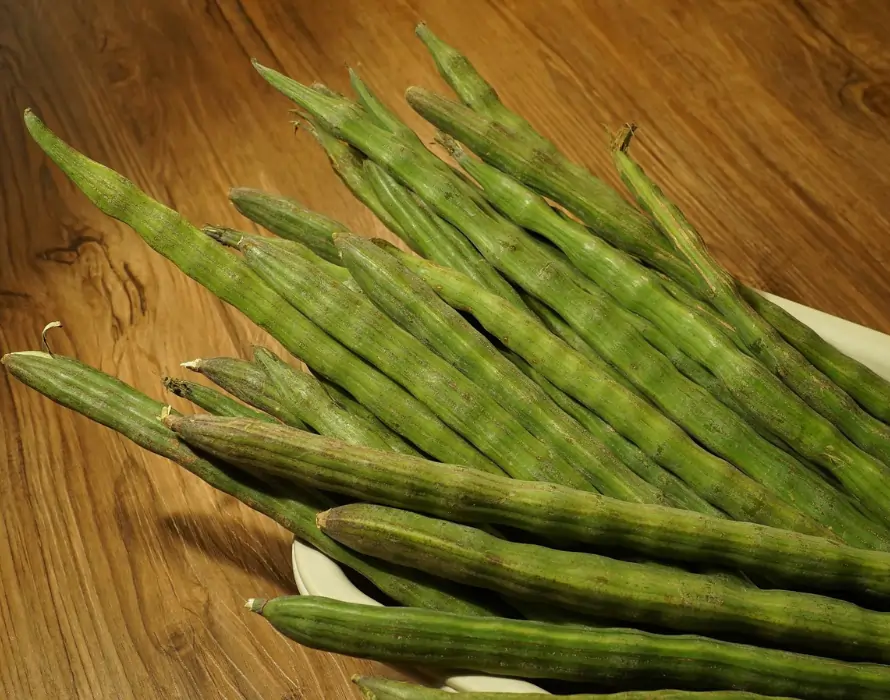Moringa pods, often called drumsticks, are a powerhouse of nutrition, offering a range of essential vitamins and minerals that promote healthy growth and development in babies. Their mild flavor and soft pulp are ideal for early feeding when introduced thoughtfully. This guide provides detailed, age-by-age instructions for safely incorporating drumstick pods into your baby’s diet, alongside their nutritional benefits and simple recipes to enhance mealtime variety.
Table of Contents
What are Drumstick (Moringa) Pods?
Drumstick pods are the long, slender fruits of the moringa tree. The pods are fibrous, with soft flesh and tender seeds inside. They are a common ingredient in soups and curries across South Asia and Africa, prized for their mild flavor and unique texture.
Nutritional Profile of Drumstick Pods
Drumstick pods are a treasure trove of nutrients, making them ideal for growing babies.
| Nutrient | Health Benefit for Babies |
|---|---|
| Vitamin C | Boosts immune function and promotes wound healing |
| Calcium | Strengthens bones and teeth |
| Iron | Supports healthy blood formation and prevents anemia |
| Fiber | Aids digestion and prevents constipation |
| Potassium | Maintains proper fluid balance and supports muscle function |
| Magnesium | Supports nerve function and energy production |
When to Introduce Drumstick Pods to Babies
Drumstick pods can be safely introduced after 8 months. Start with small amounts of pod pulp or strained juice. Ensure the fibrous exterior and hard seeds are thoroughly removed to avoid choking hazards.
How to Safely Prepare Drumstick Pods
- Wash thoroughly to remove dirt and debris.
- Cut into manageable pieces (2-3 inches).
- Boil until very soft to extract pulp.
- Discard seeds and fibrous skin to avoid choking risks.
Preparing Drumstick Pods for Different Ages
Cooking drumstick pods properly helps soften the fibrous texture and unlock their nutrition.
Drumstick Pods for Babies (8-10 Months)
- How to Serve:
Scoop out the softened inner pulp and mix it with mashed vegetables or porridge or hot rice. Do not give the fibrous husk directly. - Recipe Idea:
- Drumstick Pulp and Carrot Mash:
- Steam carrots and drumstick pods.
- Extract the drumstick pulp by scraping it out.
- Mash together and add a little ghee for flavor.
- Drumstick Pulp and Carrot Mash:
Drumstick Pods for Babies (10-12 Months)
- How to Serve:
At this age, you should still give only the softened inner pulp. Combine drumstick pulp with soft rice, khichdi, or lentils for a hearty meal. - Recipe Idea:
- Rice and Drumstick Mash:
- Boil rice until soft.
- Add cooked drumstick pulp and mix thoroughly.
- Season lightly with cumin powder for added flavor.
- Rice and Drumstick Mash:
Drumstick Pods for Toddlers (12+ Months)
- How to Serve:
Toddlers can enjoy drumstick pod subzi or drumstick pod paratha or you could add the pulp to vegetable stir-fries. - Recipe Idea:
- Drumstick Pod and Lentil Soup:
- Boil lentils with drumstick pieces until soft.
- Extract the pulp and stir it into the soup with a dash of turmeric.
- Drumstick Pod and Lentil Soup:
Common Questions and Concerns
Can babies choke on drumstick pods?
Yes, always remove the seeds and fibrous parts before serving.
Is it safe to give drumstick pods every day?
Yes, in small quantities, drumstick pods can be a regular part of meals.
Are drumstick pods hard to digest?
When properly cooked, they are soft and easy on the stomach.
How do I store drumstick pods?
Keep fresh pods refrigerated in a sealed bag for up to a week.
Can I freeze drumstick pulp?
Yes, freeze small portions for later use.
Do drumstick pods cause allergies?
Allergies are rare but monitor closely when you first introduce it to your baby.
Are the seeds inside pods edible for babies?
No, remove seeds to prevent choking hazards.
Conclusion
Drumstick pods are a nutrient-rich, versatile addition to your baby’s diet. Proper preparation ensures safe and enjoyable meals. Incorporate this superfood regularly to boost your child’s growth and well-being.


